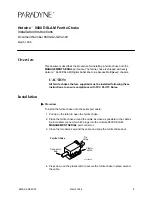
Chapter 2
Installation and Configuration
©
National Instruments Corporation
2-13
all of your chassis have been identified, the required
pxisys.ini
file
will be complete.
5.
Apply the chassis number labels (shown in Figure 2-6) included with
your kit to each chassis in your PXI system, and write in the chassis
number accordingly in the white space.
Figure 2-6.
Chassis Number Label
Trigger Configuration in MAX
Each chassis has one or more trigger buses, each with eight lines numbered
0 through 7 that can be reserved and routed statically or dynamically. Static
reservation “pre-allocates” a trigger line to prevent its configuration by a
user program. Dynamic reservation/routing/deallocation is “on the fly”
within a user program based upon National Instruments APIs such as
NI-DAQmx. Static reservation of trigger lines can be implemented by the
user in MAX through the
Triggers
tab. Reserved trigger lines will not be
used by PXI modules dynamically configured by programs such as
NI-DAQmx. This prevents the instruments from double-driving the
trigger lines, possibly damaging devices in the chassis. In the default
configuration, trigger lines on each bus are independent. For example,
if trigger line 3 is asserted on trigger bus 0, by default it will not be
automatically asserted on any other trigger bus.
Complete the following steps to reserve these trigger lines in MAX.
1.
In the
Configuration
tree, click on the PXI chassis branch you want to
configure.
2.
Then, in the right-hand pane, toward the bottom, click on the
Triggers
tab.
3.
Select which trigger lines you would like to statically reserve.
4.
Click the
Apply
button.
PXI Trigger Bus Routing
Some National Instruments chassis, such as the PXI-1006 and the
PXI-1045, have the capability to route triggers from one bus to others
within the same chassis using the
Trigger Routing
tab in MAX, as shown
in Figure 2-5. This tab allows the routing of triggers from any single trigger
bus to all of the other trigger buses in the chassis.




































